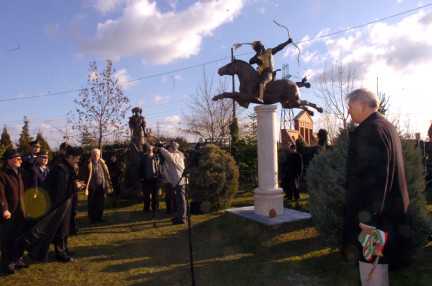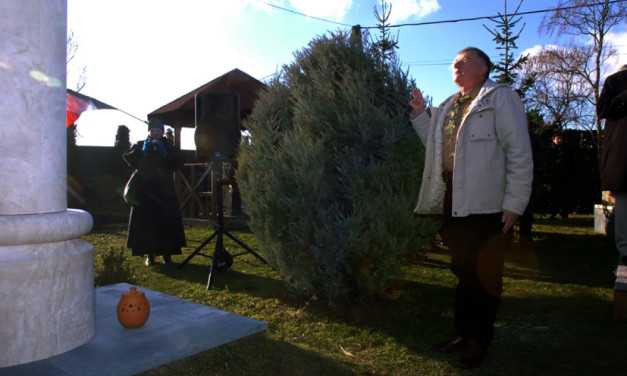Unveiling Ceremony of Etele–King Attila’s Statue
Szöveg: honvedelem.hu | 2010. december 10. 15:52Chairman of the National Assembly László Kövér, Defence Minister Dr. Csaba Hende as well as several generals, colonels, mayors, artists, patrons, the representatives of the Hungarian minorities abroad and the employees of the Zrínyi Média attended a ceremony held in the Statue Park of Hungarian Art in Budapest on December 10 where the bronze equestrian statue of King Attila the Hun – Etele – was unveiled.
Galéria
“The old tree of time sheds its leaves", this is the first line of János Arany’s poem “Buda’s Death". Now as we are standing by the statue of the great king of the Huns to pay our tribute to him, in fact we are sitting beneath this tree, wishing to discover the legendary past" – this was how Defence Minister Dr. Csaba Hende started his speech, then went on stressing “Seen from a proper perspective, King Attila’s legend does not open a dream-world for us. This is a tradition that may not have preserved history down to the last detail, in the scientific sense of the term, but it has preserved its essence very well. Today, while we are unveiling this statue, we have to pay heed to this essence."
The Defence Minister added that “according to medieval chronicles, Huns and Hungarians are related. Hungarians were members of the family of steppe nomadic tribes just like the Huns and Avars were. This extended family is stretched out along the steppes from the Carpathians to the Far East, to China".
In his ceremonial address Dr. Csaba Hende pointed out that “extremely powerful empires were rising on the steppes every time when there was a man of exceptional ability who could bring the tribes together into a large community. Historian Gábor Barta called this phenomenon “snowball-effect", since power and empire are rising in line with the growth of alliance and joining forces. This was Attila’s life’s work too".
Dr. Csaba Hende concluded his speech by stressing that “our task and mission remains the same it has been before. We have to protect this golden corner, which God created for us according to the legends, and make it into our home – a home where we start a family, bring up children and pass on life that our parents entrusted to us at our birth. Let us not forget that we belong together, so we can survive only together. God bless all dwellers of this house!"
Dr. Lajos Gubcsi, the managing director of the MoD Zrínyi Média Co. described the spiritual creed of the unveiling ceremony with the following words: “Originating from the world of steppes, the ancient Magyars had a natural brotherly relationship with the Huns. This is evident from the national mythology of Hungarians, because people can believe for a thousand years only what is real. It is evident because Árpád considered himself Attila’s heir in building a country in the Carpathian basin, and the was belted with Attila’s sword by the tribes of the blood contract. It is also shown by the fact that fathers and grandfathers tell their children these things. Those who do not believe this should go and see it for themselves on the one hand, and read more Hungarian folktales with their children on the other. The heroes of the Hungarian Conquest, the people migrating from the East came as the people of freedom.
Sándor Györfi’s beautiful artwork, the gilded bronze equestrian statue whose pedestal was made by the Renaissance Stonecutter Co. was consecrated by Parson Tibor Kusztos of Bánffyhunyad on behalf of the whole Hungarian nation.
Tamás Kiss Kobzos and the choir of Small Blackbirds went on stage during the ceremony to give a program commemorating Attila.
Lajos Gubcsi presented the Árpád Prize to the Northern Bácska Organization of the Voivodina Hungarian Scout
After the unveiling ceremony the attendees of the event proceeded to plant some oaks and pines. The saplings arrived from Hungary’s historical borders, from Gyimesbükk, Kalotaszeg and the Csallóköz, to take root by Attila’s statue. The mother earth of the Carpathian Basin feeds them. The lumps of soil were collected from ancient Hungarian lands like Gyimes, Udvarhelyszék, Marosszék, Mezőség, Kolozs County, Kalotaszeg, Királyhágó, Őrvidék (Sasony), Bihar, Hajdúság, Nagykunság, Jászság, Pest County, Kiskunság and the Pilis Hills.
As a sign of gratitude, the Zrínyi Média presented 40 packages of books to the delegations from the area of the historical Hungary so that they can forward the books to the communities of their homeland.
The unveiling ceremony of King Attila the Hun’s bronze equestrian statue finished with the joint singing of the Székely national anthem.

























